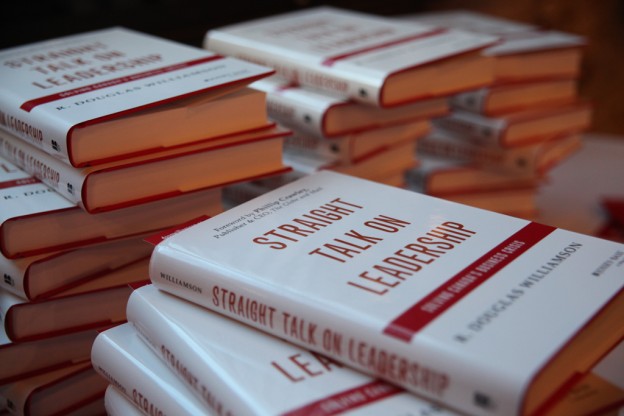
10 Questions for Bryan Hiebert
May 27, 2014
Book Review: Straight Talk on Leadership
May 27, 2014By Kayla Altman
Major obstacles to employment still persist for persons with disabilities – here’s some practical advice for removing them
The idea of discussing barriers to employment for persons with disabilities is a daunting one, involving obstacles that are embedded throughout our cultural, financial, social, physical and institutional structures. I am going to address those obstacles that I witness most often, and hope to offer a few suggestions for removing these barriers.
Recruiters, job developers and counsellors
I have been a client at a number of organizations that support employment for people with disabilities, and I have been asked at each of these organizations – always before looking at my resume – if I would be willing to work for minimum wage, and if I was capable of lifting boxes and other light labour.
It’s unfortunate then that the same organizations that seek to eliminate barriers to employment are often a fundamental part of reinforcing the idea that a person with a disability cannot be a skilled employee, someone suitable for a career or a salary. I’ve sat at these organizations with an incredible range of people – people with PhDs and astounding technological expertise, others who speak several languages and hold degrees in finance. And yet, as people with disabilities, our skills are automatically downgraded when we are asked how little we are willing to work for and what menial tasks will suffice.
Underpaid and undervalued
Recruiters and employment counsellors should actively seek out employer partners with a clearly defined commitment to access and inclusion. Candidates should be matched with roles providing a gamut of opportunities that represent the diverse skillsets and needs that people bring to the table. This means seeking out positions in technology and the arts, in hospitality and retail, and in every other market, no matter how specific or broad. According to a 2009 study released by the Canadian Human Rights Commission, only 44.9% of Canadians with disabilities aged 15 and up have full-time employment, meaning that more than 55% are underemployed, partially employed, not in the labour force or unemployed – there are plenty of candidates to fill positions in the Canadian labour market.
It is also important that the positions sought out offer stable employment with appropriate compensation. People with disabilities are often underpaid and undervalued in the workforce – it is important that, as organizations of support, you ensure that employers recognize the value of your candidates.
Institutional barriers
Often without realizing it, employers create barriers to potential candidates the moment they post a new position. Sometimes this means using overly complex application systems, or posting job descriptions and instructions that are incompatible with screen reading technology. Then, there is the job description itself – many do not indicate any commitment to inclusion, or any mention that applicants with disabilities will be accommodated during the recruitment (and retention) process, upon request. This means that an applicant with a disability may look at a job posting and determine that the organization does not support applicants and employees with disabilities.
Employers without any reference to workplace accommodations in a job description also represent themselves as not being supportive of employees once onboarded. People with disabilities should not be responsible for change-making at every step, and while an organization may be willing to adapt its policies once an applicant with a disability is hired, this leaves the employee to lead what should be an organizational commitment.
How to open the doors to your workplace
Create and communicate job descriptions that are clear and concise, written in plain language and distributed in accessible formats. Do you only accept applications online? If so, consider that candidates may not have the assistive technology to submit their application this way.
When working with recruitment organizations, partner with groups in your community that specifically offer employment supports for underrepresented groups. Be flexible in your interviewing format – consider that people communicate best in a diversity of ways, and be willing to adapt and be creative when meeting with applicants. When possible, provide applicants with a brief overview of the interview content and format – will they be meeting with one person, or will there be three? Interviews are a stressful experience, and unexpectedly throwing a candidate in with three interviewers can be overwhelming. Providing context before the interview allows candidates to prepare themselves. Also inform candidates if you intend to have them tested on certain technologies or programs, and provide a timeframe for the interview to allow for appropriate transportation arrangements.
Retention
Employers often falsely assume that hiring people with disabilities will mean a higher rate of employee turnover. Marc Wafer is the owner of several Tim Horton’s franchises in Canada, and has become known as a leader in inclusive hiring practices. At the 2013 Abilities in Mind (AIM) national conference on inclusive hiring, Wafer spoke of the benefits of hiring people with disabilities, including… higher employee retention! Retention is also at its best in environments with competitive salaries, employee benefits and support programs, and a feeling of stable employment. Roles with low pay, inconsistent hours and little flexibility do not promote high retention and often leave employees feeling undervalued and uncertain about their positions, meaning that people actively working in these roles often continue to look for something better.
Work culture
Stigma and stereotypes are some of the most widely discussed issues that negatively impact the experiences of people with disabilities. There is an assumption that having a disability is synonymous with “lacking” something – that a person with a disability will be less skilled, have less knowledge or fewer social skills. These assumptions have a tendency to spread through the culture of a workplace, popping up in the sighs of human resources staff who are asked to consider accessibility in their recruitment efforts, or in the offhanded use of a derogatory word by a colleague.
For job developers and employment counsellors, it is important to communicate to employers what makes an inclusive work environment, and what practices create barriers to recruiting and retaining people with disabilities. For employers, it is moving beyond statements of inclusion to practices of inclusion, and ensuring that potential candidates and employees are supported from the moment a position is first written.
In reality, the majority of the barriers and solutions represented here apply to all persons, regardless of disability status. The impact of confronting these obstacles and ensuring inclusion reaches far beyond persons with disabilities, and has benefits that reach across organizations.
Kayla Altman (BFA, 2011) is an Accessibility Specialist and a volunteer writer and editor with the Canadian Institute of Diversity and Inclusion, with a background in policy development, project management and communications. She has also worked with OCAD University’s Diversity & Equity Initiatives where she developed her passion for balancing accessibility with arts and culture. Kayla is also a writer and has been published in various literary journals across North America.

